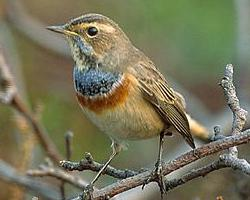
Súlyok és méretek
| Hossz | 15-tól 17-ig cm |
|---|---|
| Szárnyfesztávolság | 23-tól 26-ig cm |
Veszélyeztetettség
| Rettenthetetlen |
Állatleírás
The Common Nightingale (Luscinia megarhynchos), often heralded as one of nature's finest singers, is a small passerine bird that has captured human imagination for centuries with its melodious and complex song. This bird, belonging to the family Muscicapidae, is renowned not just for the beauty of its vocalizations but also for its role in literature, music, and folklore across different cultures.Physically, the Common Nightingale is a modest creature, with a length of approximately 15-16.5 cm and a wingspan ranging from 20 to 22.5 cm. It weighs between 16 and 22 grams. The plumage of this bird is relatively unremarkable and is primarily designed for camouflage within its habitat. The upper parts are brown, blending seamlessly into the underbrush, while the underparts are a paler buff or whitish color. This coloration allows the Nightingale to remain inconspicuous to predators while it forages on the forest floor for its diet of insects and berries.
The Nightingale is a migratory bird, spending its breeding season in the forests and woodland areas across Europe and parts of Western Asia. During this time, males establish territories and sing both day and night to attract mates and to ward off rivals. The song of the Nightingale is not only beautiful but also remarkably powerful, with some reports suggesting it can be heard from up to a kilometer away in the still of the night. The song consists of a series of whistles, trills, and gurgles, and each male has a unique repertoire that can include over 250 different song types.
After the breeding season, Nightingales migrate to sub-Saharan Africa, where they spend the winter in dense scrub or forests. This long journey is a testament to the bird's endurance and navigational skills, which remain subjects of scientific study and fascination.
Breeding habits of the Nightingale are quite traditional; the female builds a nest on the ground, hidden among vegetation, where she lays 4 to 5 eggs. The eggs are incubated for about two weeks before hatching, and the chicks are then fed by both parents until they are ready to fledge.
The Common Nightingale's preference for dense, shrubby areas means that its habitat is often threatened by human activities such as agriculture, urbanization, and deforestation. Although currently not considered endangered, the species has faced declines in certain areas, prompting conservation efforts to preserve its natural habitats.
The cultural significance of the Nightingale extends far beyond its biological characteristics. Throughout history, it has been a symbol of love, melancholy, and the fleeting nature of beauty, featured prominently in poetry, songs, and stories from various cultures. Its enchanting song continues to inspire and captivate those who have the privilege of hearing it, making the Common Nightingale a beloved figure in both the natural world and the realms of human creativity.
Hasonló állatok
Új állatfotók
Top 10 állat
- Diana monkey (Cercopithecus diana)
- Dolphin gull (Leucophaeus scoresbii)
- Moustached guenon (Cercopithecus cephus)
- Galápagos tortoise (Geochelone nigra complex)
- Stone loach (Barbatula barbatula)
- Common house mosquito (Culex pipiens)
- Japanese spider crab (Macrocheira kaempferi)
- Colossal squid (Mesonychoteuthis hamiltoni)
- Common reed warbler (Acrocephalus scirpaceus)
- Sea urchins (Echinoidea)


